3 Questions: MIT biologist on new resveratrol study

In the early 1990s, MIT professor Leonard Guarente discovered that sirtuins, a class of proteins found in nearly all animals, protect against the effects of aging in yeast; similar effects have since been seen in many other organisms. In 2003, David Sinclair, who had been a postdoc in Guarente's lab, found that resveratrol, a compound found in grapes and red wine, can also counteract the effects of aging. Since then, many scientists have tried to tease out the exact relationship among sirtuins, resveratrol and aging.
In a paper appearing this week in Science, a team led by Sinclair, now a professor of genetics at Harvard Medical School, shows for the first time that resveratrol and similar compounds act by directly activating sirtuins. Guarente, the Novartis Professor of Biology at MIT, discusses the significance of the new finding.
Q: There has been some scientific disagreement over whether resveratrol helps sirtuins to slow the aging process. What is the basis of this disagreement?
A: Between 10 and 15 years ago, we and others proposed three features of sirtuins that we thought were demonstrated at that time. One is that they regulate aging; the second is that they mediate the beneficial effects of calorie restriction; and the third is that they can be activated by small molecules like resveratrol. In the intervening decade or so, all three of those claims were challenged, one way or another. There was a paper published a few years ago that said basically the compounds don't work. In recent years, one by one the original claims are being upheld.
Regarding resveratrol and related compounds, there are three schools of thought. One is the compounds don't do anything vis-à-vis sirtuins, but deliver benefits as antioxidants. Another is that they're activating sirt1 (the major mammalian sirtuin) in cells, but it's an indirect effect of something else that they're doing in cells. The third possibility is that they're having a direct effect on sirtuins.
Some people have doubted this last possibility, because most small molecules that act as drugs inhibit enzymes, instead of activating them. It's easy to see how you could get a small molecule in the wrong place and block an enzyme, but to see it activating an enzyme is more rare. So people said these compounds don't really work that way in living cells, and they must be doing something else.
Q: How does the new study help to resolve that question?
This paper, I think, provides findings that are very difficult to interpret in any way other than direct activation by the compounds. The strongest evidence in the paper is that they found they could change one amino acid of the protein, from glutamate to lysine, and that change had no effect at all on the catalytic properties of the enzyme—the enzyme still works the same way as far as you can measure, there's no difference between the mutant and the control. However, the mutant is completely dead with regard to activation by resveratrol. They also tested some of the newer compounds—I believe it was about 100 of them—and found the same thing. The mutant enzyme was either inactive or much less activatable than the normal version.
They then engineered cells that would express either normal sirt1 enzyme or the enzyme that has the single amino-acid change. The cells that express the normal enzyme respond to the activation with real biological readouts, like activation of mitochondria, which is one of the things sirt1 is known to do, whereas cells with the mutant enzyme do not respond.
So if you put all this together—the studies in the test tube, and in cells, I think it makes a convincing case that all of these compounds, including resveratrol, must act directly on the enzyme to boost its activity.
Q: What would be the potential benefits of taking drugs that mimic the effects of resveratrol?
A: We think that aging is a component of many diseases or conditions, such as diabetes, Alzheimer's disease and arthritis. Generally speaking, these occur late in life. The idea is that if you could target a molecule that could regulate the aging process, you could control these diseases. There's a lot of genetic data in mice that shows you can activate sirt1 genetically, and that is protective against all of these age-related diseases. So the logical surmise would be that any compound that could activate sirt1 might have benefit against those diseases.
The initial study by Sinclair and Howitz 10 years ago identified resveratrol and other natural products that were of a class called polyphenols. They're found in plants and in grapes, and in red wine. That sparked the biotech industry to develop new synthetic compounds that are not natural products, and that work better than resveratrol. There are hundreds of those now. These are the lead compounds for what are being tested in human clinical trials now for protection against diseases of aging.
People who develop drugs always want to make sure they understand what the real targets of the drugs are. The idea that resveratrol—but moreover, the newer compounds that are being developed for humans—are directly hitting sirt1 as the target, I think will be a green light for further drug development.
More information: medicalxpress.com/news/2013-03 … ersal-mechanism.html
This story is republished courtesy of MIT News (web.mit.edu/newsoffice/), a popular site that covers news about MIT research, innovation and teaching.















